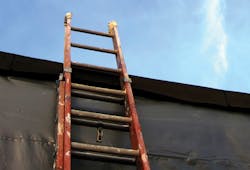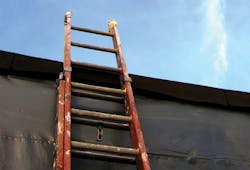The Case of the Hurried Electrician
A business man who had recently bought a building for use as a car repair shop knew from the start that he had a number of electrical problems to solve. So after taking possession of the space, one of the first things he did was call a master electrician in to address the lighting issues. A very busy man in high demand, this electrician eventually agreed to fit the garage owner into his tight schedule.
The scene
Arriving one morning at 4 a.m. unannounced, the electrician asked the one employee on duty at the time to turn on the parking lights. The front of the one-story building, which featured a flat roof, faced the road and had two roll-up doors with a large fluorescent sign placed on the front facade. The parking lot contained four lighting poles with feeds from the roof, where a sub-panel controlled the four sets of lights for the four poles.
The accident
After receiving verbal permission by phone from the owner, the employee turned on the lights for the electrician, who proceeded to climb his ladder to test the connections on the lights at the weatherhead on the roof. Once he finished testing, the electrician began to climb down the ladder. As he descended, something unexpected happened. Touching his hand to the metal frame of the fluorescent sign, he received a shock — despite the fact that his ladder was made of fiberglass. This unexpected jolt caused him to lose balance and fall approximately 6 ft to the ground.
Although the effect of the shock was negligible — there were no visible signs of burning or any inconsistencies in the behavior of his heart or nerves upon medical evaluation — the way in which the victim fell caused severe fractures in both of his legs. Approximately 15 min. after the accident, EMTs arrived at the scene and administered drugs to help the electrician cope with the extreme pain. After medical evaluation, it was later determined that the fractures would never heal properly, requiring the 30-year-old victim to walk with a cane for the rest of his life.
The lawsuit and allegations
After the accident, the electrician (plaintiff) sued the owner (defendant) for damages, testifying that he was hired to check the non-working parking lights — not to look at the fluorescent sign. He maintained that he should have been made aware of this unforeseen danger at the work site before starting the job.
His attorney further argued that the defendant knew the sign was malfunctioning and had prior knowledge that it possessed a short circuit, causing the outer metal frame of the sign to become electrified. Although the owner did suspect there was trouble with the sign, he claimed it had a buzzing sound when turned on, which he asserted should have been reason enough for the electrician to be careful. The defendant’s legal team argued that as a non-electrician, the building owner took the proper course of action in hiring a master electrician to fix his wiring problems; therefore, he was not liable for the accident.
The plaintiff’s attorney stated that buzzing in fluorescent lights is a common phenomenon and cannot be considered a reasonable warning. He further claimed that it would be unreasonable for an electrician to assume that all electrical wiring on the premises was malfunctioning, basically requiring him to check each and every device unless specifically asked to do so.
Not surprisingly, the two parties disagreed on who said what and at what point in time. The electrician claimed he had not been informed about the sign by the shop owner, who purported that he did, in fact, give the electrician a verbal warning about all of the electrical wiring on the premises, including the sign.
The plaintiff’s attorney alleged that the employer had sufficient knowledge about the malfunctioning fluorescent sign but had not told the electrician about it. This failure to communicate such an important piece of information about the premises led to the accident.
Investigation and analysis
The plaintiff’s expert stated that exposed non-current-carrying parts of electrical equipment must be effectively grounded. The sign should have followed this requirement. By failing to ground the casing of the sign, the defendant had failed to comply with NEC regulations. The expert also claimed that by failing to implement the lockout/tagout of the sign or fully disconnecting the sign, the owner failed to properly guard the sign, thus failing to provide reasonable and adequate protection. The grounding to the sign was found to be connected but rusted. The prosecution argued that had the employer turned off and locked out the power source to the electrical supply to the sign, it would not have been energized — ultimately avoiding the dangerous situation.
Five years after the accident happened — and several months before the trial was set to begin — the defendant retained my forensic engineering team to provide an expert opinion. We argued that the accident was a result of the electrician’s negligence and failure to observe safety precautions while on the premises. Having no knowledge of electricity, the owner was in no position to forewarn a licensed electrician about the premises. Furthermore, the electrician arrived during non-routine hours at 4 a.m. to conduct his work (which lasted only about 10 min.). Due to the fact that the electrician was sandwiching this job into his otherwise extremely busy schedule, we introduced the possibility that he could have demonstrated a lack of focus on his work, which would make him possibly careless.
There was one other piece of evidence that struck us as potentially contradictory regarding the plaintiff’s deposition. Why were there no burns whatsoever on the electrician’s hand? Could it be that the alleged “shock” the electrician felt was, in actuality, just the irritation of hitting the sharp edge of the sign? We wanted to investigate the sign and all of its wiring further. We also wanted to test the electrician’s fiberglass ladder, which supposedly would not have permitted an electric shock as described in the testimony. Unfortunately, after five years, the site of the accident was completely remediated. The ladder could not be found; it was presumed to have been sold, along with a great deal of the electrician’s equipment approximately three years after the accident. By the time we were brought into the case, the electrician was back working for a large electrical contractor in a physically passive role that involved supervising others on a job site. Therefore, he no longer had a need for the equipment he once owned as an independent electrician.
We argued for the defense that a reasonably prudent electrician would be on notice that the premises were in a state of disrepair, increasing the chances that there could be an unknown or unexpected electrical hazard capable of inflicting a lethal shock. Under such circumstances, caution is always warranted, especially when touching any exposed metal part of electrical equipment.
The defense also argued the following points:
1. The electrician should have placed an easily available non-slip rubber mat under the ladder, which would have insulated the ladder from the ground and prevented the electrician from completing the circuit for the shock current.
2. The electrician should have been wearing commonly used and readily available low-voltage protective gloves that would have protected him from a shock when touching an energized object carrying voltages up to 600V.
3. Given the proximity of the fluorescent sign to where the electrician was on the ladder, he should have noticed that the sign was energized, even if the person who had turned it on did not do so under his direct supervision. In addition, the electrician should not have allowed someone to turn on the sign without his knowledge and permission.
4. The electrician had a proximity voltage tester (PVT), which would have allowed him to determine if the sign’s frame was energized or not. Basic safety sense dictates that all appliances are suspect and should be tested for any voltage before being touched.
5. Because the owners of the property were not electricians, they had no way of knowing that the frame of the sign was energized when turned on. Although all of the regulations cited by the prosecution regarding the grounding of the sign were correct, they could not be implemented by the owner. That is why he called a licensed electrician.
6. Even if the owner had known the sign was malfunctioning, he had no reason to believe that the licensed
electrician would need to be warned about any dangers attendant to the performance of this job.
The plaintiff’s expert had cited failures of the owner to provide a safe working environment. He cited two industry references:
1) Section 110.4(B) of NFPA 70E
2) Sections 250.4(A)(2) and 600.7 of the NEC.
We argued for the defendant that these requirements and others similar to them would place the burden of enforcement on the professional — the master electrician — not on the owner. We also did a study on fiberglass ladders that demonstrated how they could break down and conduct electricity if they were neglected. This latter testing was submitted as evidence in the trial, but it was deemed inadmissible due to the fact that the actual ladder used on-site the day of the accident was not available.
Outcome and lessons learned
The case settled in favor of the plaintiff for approximately $1 million. Several important results came out of this case.
Time is of the essence when dealing with evidence. We were the only experts hired by the defendants, but it was more than five years after the accident. Oftentimes, when hired late on a case, we can use data collected by the opposing expert. In this case, however, the plaintiff’s expert did only a superficial job. Although he took no measurements — because he performed a site visit only days after the accident — his report trumped ours. Ultimately, his opinion was held in higher esteem. His citations of codes and standards early in this matter made him appear to be the expert to members of the jury. Although we contradicted this expert’s reading of the codes, our alternate theories about how this accident may have occurred were deemed speculation, at best.
In the end, both sets of experts agreed on one thing in court: There was a lack of communication on the part of the owner and the electrician. A written estimate should have been drawn up beforehand. This normally is done to make the price of the job clear to both parties. Had an estimate been drawn up in this case, the work to be done would have been clear to all concerned and increased the possibility of a safe outcome.
Hmurcik is a consultant at Lawrence V. Hmurcik, LLC. He can be reached at [email protected]. Patel is a Ph.D. candidate at the University of Bridgeport, Bridgeport, Conn. He can be reached at [email protected].

